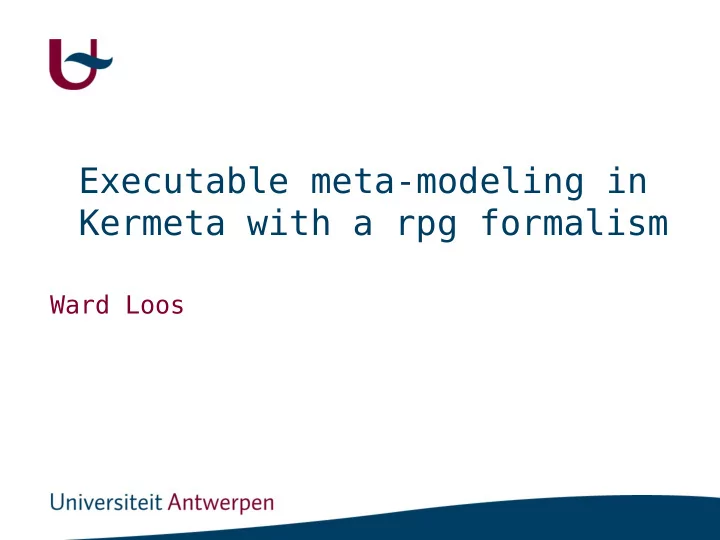

Executable meta-modeling in Kermeta with a rpg formalism Ward Loos
Kermeta overview • Tries to be common denominator between modeling languages • Object-oriented and statically typed • Framework depends on standardized technologies by the OMG • Uses Eclipse Modeling Framework (EMF) • Workbench provided as eclipse plugin • Java interpreter 2
Modeling features • Compliant with OCL • Extends EMOF • Associations with multiplicities • Both structural and behavioral code in meta-model 3
Standardized techniques (1) • Meta-Object Facilities (MOF): - Four-layered architecture - Provides meta-meta model in M3 - Meta-model for UML - Kermeta uses Ecore variant defined by EMF 4
Standardized techniques (2) • Object Constraint Language (OCL) provides contraint and query expressions for MOF models • XML Metadata Interchange (XMI): - Standard for exchanging metadata - Metadata whose meta-model can be expressed in MOF 5
Other features (1) • Mainly object-oriented: - (abstract) classes and methods - Properties - Multiple inheritance - Exceptions - Generics - Namespaces 6
Other features (2) • Design by contract • Aspect-oriented programming • Statically typed Missing: • Constructors • Return, break and continue statements 7
(Meta-)Model creation and storage • Meta-model defined in Kermeta source file (kmt) • Converted to ecore meta-model for model creation • Model creation in EMF • Models validated with ecore meta-model • Kermeta needs a root element 8
Kermeta workbench • Eclipse plugin • Syntax highlighting and type checking • Debugger • Interpreter • Conversion from kmt to ecore (and back) 9
Eclipse Modeling Framework • Eclipse plugin • Generate and edit ecore diagrams (variant of UML diagrams) • Generate ecore meta-model from diagram • Visual editor for models • Other tools can be used 10
Kermeta 2 • Released in 2012 • Uses Scala instead of Java • Allows compilation to bytecode for the JVM 11
RPGame ecore diagram 12
RPGame model 13
Convert AToM^3 model to XMI (1) • Button added to buttons model • General strategy: - Parse all elements from ASGroot object - Create objects from parsed elements - Objects keep track of sub-elements - Then parse all links and fill in blank spots in objects - Nested for-loops to create XMI file 16
Convert AToM^3 model to XMI (2) 17
Future work • Default export function for AToM^3 models to XMI • Use Kermeta for model transformation from AToM^3 to Kermeta model 18
Reference • On Executable Meta-Languages applied to Model Transformations,P Muller, F Fleurey, D Vojtisek, Z Drey, D Pollet, F Fondement, P Studer, and J Jézéquel (2005) 19
Questions? 20
Recommend
More recommend